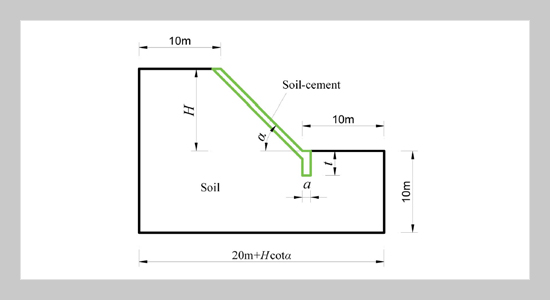Yanxin Yang This email address is being protected from spambots. You need JavaScript enabled to view it.1, Qinke Wang1, Jianlin Ma1 and Fengjuan Huang1 1Department of Geotechnical Engineering, Southwest Jiaotong University, Chengdu, Sichuan 610031, P.R. China
Received:
December 4, 2018
Accepted:
July 9, 2019
Publication Date:
September 1, 2019
Download Citation:
||https://doi.org/10.6180/jase.201909_22(3).0006
Many stabilization methods exist to improve slope stability. One of them is using soil-cement improvement technique. The method used the soil-cement slices constructed on the surface of a slope based upon a certain spacing across the slope with a shear key embedded deeper in slope. Parametric analysis of slope improved with soil-cement-based method was conducted using Shear Strength Reduction Finite Element Method (SSR-FEM). An ideal slope was used to analyze the variation of factors of safety. The factors of safety of the slopes treated with soil-cement-based stabilization were improved comparing those without treatment.Various factors of the slopes that controlled the factor of safety were studied in the parametric analysis.The increases of the internal friction angle, the cohesion of the soil of the slope, the length of the short edge and the depth of embedment will improve the factor of safety. Moreover, the analysis results show that the internal friction angle of soil were correlated with the factor of safety in the exponential relationship, and the cohesion of soil, the length of the short edge and the depth of embedment were correlated with the factor of safety in the linear relationship. The value of interface strength reduction coefficient was correlated with the factor of safety in the logarithmic relationship. However, the interface strength reduction coefficient has less effects on the factor of safety comparing to the other factors. The factor of safety varied with the spacing of slice,and an optimum spacing could be determined based on the distribution of factor of safety. The soil arching effects were also explored and found they improved the factor of safety. Two case histories of slopes were analyzed and the improved factor of safety was proved for each case.ABSTRACT
Keywords:
Parametric Analysis, Stability Analysis, Slope, Soil-cement, Stabilization
REFERENCES
















